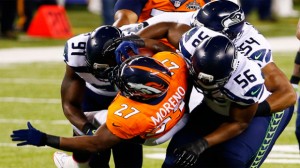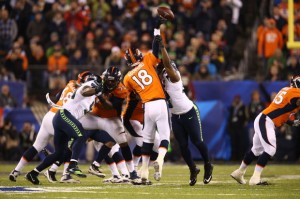What’s happening here?
There was a great deal of commentary by the sports pundits in the immediate aftermath of Super Bowl XLVIII. The dust has since settled and we can now think more clearly about how the score of Seattle Seahawks 43, Denver Broncos 8, came to be.
How could this have happened? Going into the game, the Broncos had set a bunch of National Football League offensive records, including a remarkable average of nearly 38 points per game.
And meanwhile, the Seahawks established themselves as the clearly dominant defensive-oriented team in the NFL. So the game was framed by the media as a battle between the best offense and best defense.
The sports world’s conventional wisdom that a dominant defensive team will beat a dominant offensive team in the Super Bowl seems to have been reinforced by the game’s outcome, and sportscasters and other football experts were quick to say so.
And yes, the Seahawks outplayed the Broncos – but how? How was it they were able to do that? Are great defensive strategies inherently superior to great offensive strategies?
Inherently? No. It depends on the characteristics of the two strategies in conflict.
The problem
Of course the Broncos didn’t suddenly become a poor team on game day. The relevant point wasn’t that a great defense beat a great offense, but that a highly disruptive team defeated a highly tuned team. That’s what happened.
(Offenses can certainly be as disruptive as defenses. That’s how the Broncos, themselves, got to the Super Bowl: with a disruptive offensive strategy. To mention a few aspects, their use of relatively few huddles and ultra-quick pass releases, together with employing a large mix of plays, kept their opponents’ defensive teams back on their heels and unable to get enough traction to sufficiently interfere with the Bronco juggernaut. (For more on the disruption of defensive strategies, see The Great Wall; Defensive Strategy, for example).
All that matters is who’s the disruptor and who’s the disruptee.
In the case of Super Bowl XLVIII, Seattle was the disruptor. The highly tuned Bronco offense was quickly detuned by the extraordinarily disruptive play of the Seahawks’ defense. Pass interceptions, stripping the ball and causing fumbles, tipping and blocking passes resulting in incompletions, etc, etc – causing every kind of turnover, and preventing the Bronco offense from having the time on the field it needed to get in its groove and rack up points.
Seahawks’ great pass coverage and rushing put the quarterback under relentless pressure and defeated the Broncos’ bread & butter passing game. And their excellent play prediction and reliable tackling shut down the Broncos’ only remaining offensive avenue, its running game.
Fragility
The fundamental problem is that highly tuned systems of any kind are fragile, and when disrupted, soon fall apart. This is seen, for example, in the post: Defeating Control Strategies.
Back to football. The plays are highly scripted and players learn them well through an extraordinary amount of repetitive training. The plays are executed like clockwork.
But throw a little sand between the tick and the tock, and the clock grinds to a halt.
When timing is interfered with, what was once the right thing to do becomes the wrong thing to do. An easy pass becomes an interception, an opening for a run becomes a wall of tacklers.
Confidence and morale drop, leading to hesitancy which further interferes with timing, resulting in more wrong actions. More wrong actions lead to even more wrong actions, creating a downward spiral.
It was all too easy and painful to watch the Broncos’ offense (and also defense) ride that spiral down. It wasn’t a case of defensive strategy being inherently more effective than offensive strategy; it was a disruptive strategy playing hell with a beautifully tuned strategy.
Psychology
When things going wrong cause more things to go wrong, and confidence wanes, psychology becomes a key factor in the situation. Enter hope & fear.
At this point there’s a shift from making decisions based on a clear perception of the situation to basing them on wishful thinking or unwarranted fear. Blind, even-handed Reality then steps in, asserts itself, and smites the disruptee for its mistakes. So it was for the Broncos on 2 Feb ’14. And so it is for any disruptee, whether in sports, war, business or love.
Do not a disruptee be.
Disruption, generally speaking
What is it about a highly tuned strategy that makes it vulnerable to disruption? Organizations of any kind embody strategies: they have generally held objectives, barriers to those objectives, weaknesses in those barriers that they can attack, advantages in their resources they can attack with, and various ways they can exploit their advantages against their barriers’ weaknesses. Which is to say they have strategies.
There is a natural process by which the strategies become tuned. For example, people in a system (say an organization) collectively learn what works best during some period of relative success, and maximize on that. People who are good at it and can act on it are promoted. Resources flow into activities that support further refinement of the strategy, executed by people who are even more specialized in various aspects of the strategy.
All the while, the system has become better at precisely what it does, and runs smoothly, but at the same time loses the flexibility to do other things well. It has become more specialized and less generalized.
So when something comes along that is contrary to the underlying assumptions on which the system and its strategies are based, and the system is called upon to do something other than what it has become highly tuned to do, the strategies fail and the system is disrupted and breaks. The more highly tuned, the more fragile; and of course the more fragile, the more likely to break down.
This can be seen clearly in the technology business world. Companies such as Univac, Digital Equipment Corporation and Control Data Corporation highly and profitably optimized around the assumption that computers should be centralized resources. Then came the advent of personal computers, violating the companies’ underlying assumptions, and disrupting them out of existence.
Meanwhile, companies such as HP and Dell profitably optimized their computer businesses on the new assumption that computers should mainly be personal and based where people work and live. Then came the advent of mobile computing …
So now the trend in technology business is to try to start a company with a technology that will disrupt the highly tuned dinosaurs in its industry, make it big, and get out before it becomes a dinosaur, itself. And this is what is taught in B-Schools today.
As pointed out earlier, it’s not just business or football in which disruption can be a critical factor in success or failure. In fact all living systems, the systems they create, and the strategies embodied by those systems are subject to this factor. For better or worse.
So we’d do well to learn how to disruption-proof our strategies. A topic for another time.
________________________________________________________________
Readers are encouraged to add comments to this post.
And if you’d like to share or recommend the post, click on your preferred way in the left margin sidebar.
If you’re not currently being automatically notified when new posts are published, then please Follow Real Strategy (top of right hand column on this page), and indicate how you’d prefer to be notified.
For other posts of interest, click the Smart Menu tab.
References
Photo Credit: Shutting down the running game, Sports Illustrated, http://sportsillustrated.cnn.com/nfl/news/20140203/seattle-seahawks-denver-broncos-super-bowl-xlviii/
Photo Credit: Shutting down the passing game, nj.com, http://www.nj.com/super-bowl/index.ssf/2014/02/super_bowl_2014_denver_broncos_vs_seattle_seahawks_–_live_analysis_and_fan_talk.html
Photo Credit: Lady Reality, actually Lady Justice, Wikipedia, The Gerechtigkeitsbrunnen, http://en.wikipedia.org/wiki/Gerechtigkeitsbrunnen_(Berne)









Nice explanation. Glad to see you doing this blog again.
[Translate]
Thanks Tom – glad to be back at it.
[Translate]
Good article, Bill. Nice to read some objective rationalization of the Broncos loss – helps to ease the pain a bit. Like Tom, I’m glad to see you are writing again!
[Translate]
Thanks for the comments, Mike. It’ll be interesting to see what the Broncos DO about their vulnerability to disruption (which won’t have been lost on their other opponents). What sort of strategy will they develop? I hope they don’t just try to do what they already do, better. In any case it should give us something interesting to watch for next season.
[Translate]